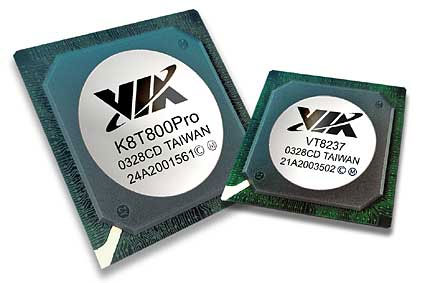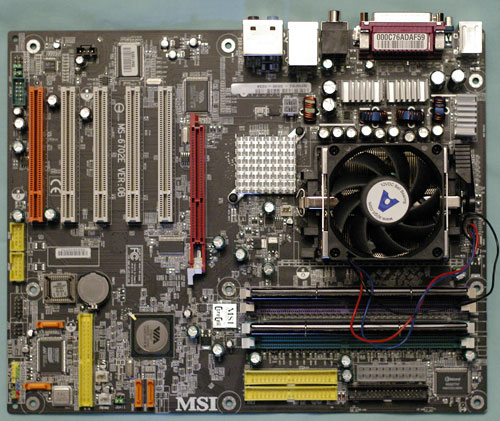Socket 939 Chipsets: Motherboard Performance & PCI/AGP Locks
by Wesley Fink on June 2, 2004 12:01 AM EST- Posted in
- CPUs
Basic Features: VIA K8T800 PRO Reference Board

| VIA K8T800 PRO Motherboard Specifications for 939 MSI MS-6702E (K8T Neo2) |
|
| CPU Interface | Socket 939 Athlon 64 and Athlon 64 FX |
| Chipset | VIA K8T800 PRO/VIA VT8237 |
| CPU Ratios | None |
| HyperTransport | Auto, 1Ghz, 800MHz, 600MHz, 400MHz, 200MHz |
| Bus Speeds | 200MHz to 250MHz (in 1MHz increments) |
| PCI/AGP Speeds | Automatic, Async at 66.8 or 75.4 |
| Core Voltage | No Adjustments |
| DRAM Voltage | No Adjustments |
| AGP Voltage | No Adjustments |
| Memory Slots | Four 184-pin DDR DIMM Slots Dual-Channel Configuration Regular Unbuffered Memory to 4GB Total |
| Expansion Slots | 1 AGP 8X Slot 5 PCI Slots |
| Onboard Serial ATA RAID | VIA 8237 (2 Drives, 0, 1) |
| Onboard IDE | Two Standard VIA ATA133/100/66 (4 drives) |
| Onboard USB 2.0/IEEE-1394 | 8 USB 2.0 ports supported by 8237 No Firewire |
| Onboard LAN | VIA VT6122 Gigabit LAN |
| Onboard Audio | VIA VT1616 codec AC '97 2.3 6-Channel with UAJ |

While both Reference Boards were manufactured by MSI, it is important to note that they were different from each other in some important ways. The VIA-based 6702E was a special board produced by MSI for AMD - mostly for review and qualification of the Athlon 64 Socket 939 CPU. While this K8T800 PRO board is based on the upcoming MSI K8T Neo2, it is missing the voltage controls and adjustments that are included on production boards. By contrast, the nVidia-based 7025 was an all but finished production version of the K8N Neo2 Platinum, with all of the ratio and voltage adjustments that you will see on the shipping K8N Neo2. We were assured that the performance of both boards was close to what will be found on production Neo2 boards for Socket 939, but you will still likely see some changes in adjustments and performance on the final shipping motherboards from MSI. Still, the opportunity to do a direct comparison of Socket 939 boards from the same manufacturer was too good to pass up.
Basic Features: nVidia nForce3-250Gb Reference Board
Performance Test Configuration: Chipset Comparison










20 Comments
View All Comments
Wesley Fink - Friday, June 4, 2004 - link
#12 and #19 -We received the 2nd motherboard less than 24 hours before leaving for Computex, and did not sleep so first test results could be carried with us to Taiwan - so we could post when NDA expired while we were at Computex. The article was written in-between visiting booths 8000 miles from home - to bring you coverage of the show. Right now I am in Zhongshan, China and will not return until late next week.
We will test 4 dimms when we review the first SHIPPING 939 boards - when we return from China. I rarely have Reference boards and a stock test bench with me in mainland China.
SpaceRanger - Thursday, June 3, 2004 - link
What bothers me, is that days later, questions still go unanswered. Not cool Anandtech. Your reputation is slipping.daveshel - Thursday, June 3, 2004 - link
Do the enthusiasts reading this article agree that we tend to upgrade motherboards more often than processors? Not true for me.FacelessNobody - Wednesday, June 2, 2004 - link
Another factor I'd like to see included in this roundup is RAID performance. Based on this review, I like the nForce3 250 more, but I've heard that VIA is ahead in their SATA RAID implementation. With the two chipsets so close, RAID performance could easily be a determining factor, not to mention one that means more to me (and probably others) than PCI/AGP locks.Eidolon - Wednesday, June 2, 2004 - link
if nVidia isn't going PCI-Express until Q3 or Q4, who is doing it like this or next month? VIA and SiS?HolgMan - Wednesday, June 2, 2004 - link
Will there be any Socket 940 Boards with either nForce3-250 or K8T800 Pro?Wesley Fink - Wednesday, June 2, 2004 - link
#10 -nVidia is showing PCI Express boards for Athlon 64 Socket 939 at Comdex. While the PCI Express boards are an unannounced product, nVidia says we may seen these as early as 3rd quarter.
MemberSince97 - Wednesday, June 2, 2004 - link
# 12 Very good point...SpaceRanger - Wednesday, June 2, 2004 - link
I saw 4 DIMM slots, but they didn't go into how stable and at what speeds these boards were capable of running with all 4 DIMM slots filled. Anyone know?Nyati13 - Wednesday, June 2, 2004 - link
#9 That is because the most important parts of what used to be a 'Northbridge' are now in the CPU itself, which leaves much less for the motherboard chipset to do.
Jeremy